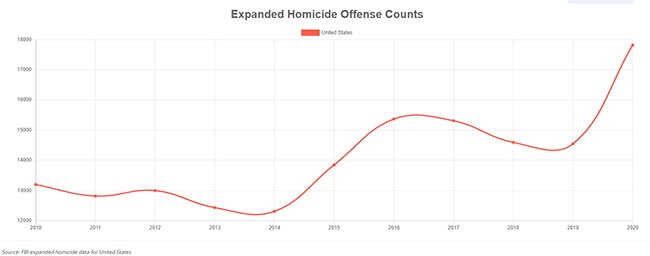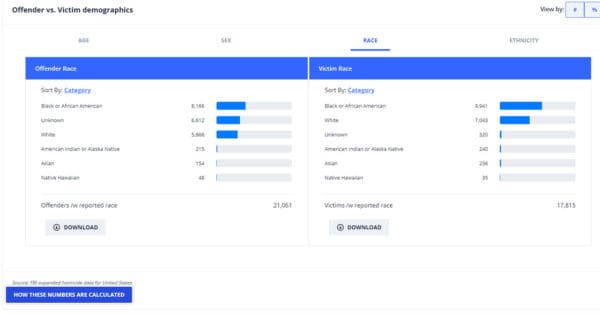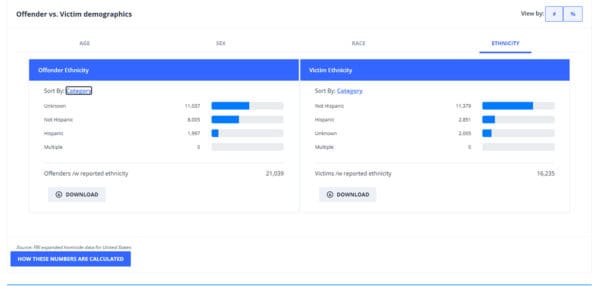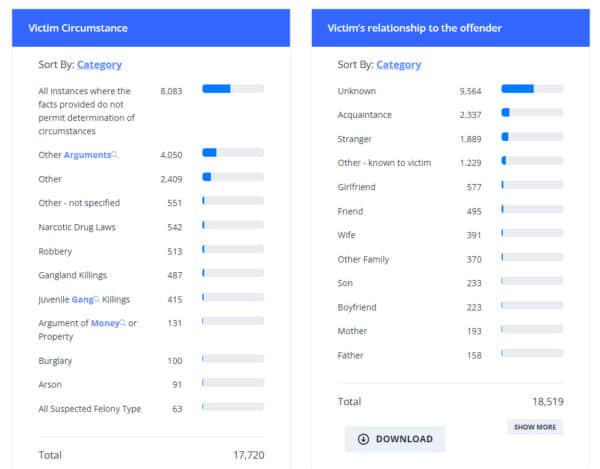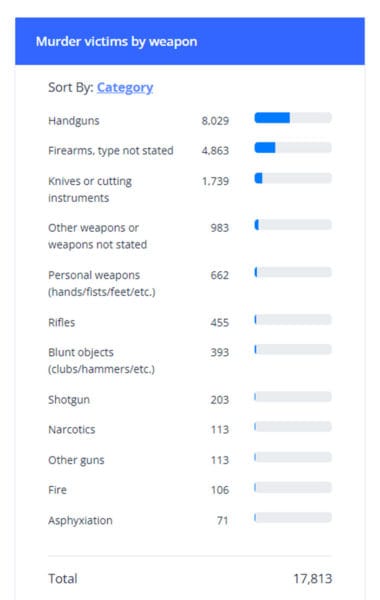The Year of ‘Black Lives Matter’?
- Post AuthorBy Gregory Hood and Jared Taylor
- Post DateThu Sep 30 2021
The FBI just released its Expanded Homicide Data (EHD) for 2020, which includes reports from 15,875 of 18,623 American police agencies. Murders rose by about 30 percent. It is safe to assume that this is the result of Black Lives Matter lawlessness and “progressive” crime fighting.
Notice the two increases that correlate roughly with Michael Brown’s death in Ferguson in 2014 and George Floyd’s death in 2020.
In 2020, there were 3,267 more homicides than in 2019 for a total of 17,815. Who were the additional victims? There were 950 more dead whites (which included an unknown number of Hispanics), but no fewer than 2,164 more dead blacks. Thus, in 2020, the year “black lives matter” was shouted in the streets, celebrated in sports arenas, chanted in schools and corporations, and practically made the national motto, 2,164 more blacks lost their lives to homicide than the year before. Almost all were killed by other blacks. Unlike the fake martyrs of the BLM movement — Trayvon Martin, Freddie Gray, Michael Brown, George Floyd — these victims have been all but ignored. Nothing could more clearly prove the degeneracy of a movement into which Americans poured billions of dollars in donations.
Who were the killers in 2020? Of 21,061 offenders, 6,612 were of “unknown” race.
Click here for the full-size version.
Of the remaining 14,449, 8,166 (56.5 percent) were black. Race of offender is not known when there is no arrest and no witness reports. This is most likely in black areas, where witnesses are less likely to come forward and clearance races are low. Therefore, it is probably safe to assume that more than 56.6 percent of the “unknown” offenders were black. The Anti-Defamation League says the “13/50” meme — which refers to the fact that 13 percent of the population (blacks) commit 50 percent of the murders — is “racist propaganda.” It is an understatement.
If we make an assumption very generous to blacks — that they are no more likely to be among the “race unknown” than the “known” offenders — and if we use a figure of 13 percent for the black population, this calculation (56.6/13)/(43.4/87) tells us that any given black is 8.7 times more likely than any given non-black to kill someone. This figure is called an “odds ratio.”
What about whites? Calculations are a lot harder. Federal crime reports treat Hispanics not as a race but as an ethnicity, assuring us that Hispanics can be “of any race.” They are therefore treated separately, and the FBI reports 1,997 Hispanic offenders and 8,005 who were clearly not Hispanic, but 11,037 offenders for whom Hispanic/non-Hispanic is unknown. In other words, at the national level, we have only a vague idea of how many Hispanic offenders or victims there were.
Click here for the full-size version.
Of these 1,997 known Hispanics, how many were categorized as white? Probably almost all of them. If we assume that roughly 75 percent were classified as racially white, we can make a rough calculation of the number of white non-Hispanic offenders by subtracting 1,500 (roughly 75 percent) of the Hispanics from the 5,866 offenders classified as white. That leaves 4,366, or 30.2 percent of the offenders whose race was known.
Based on this approximate number, what is the black/white offender odds ratio? If we take the white population as 61 percent, the calculation (56.6/13)/(30.2/61) gives us an odds ratio of 8.8, meaning that any given black was 8.8 times more likely than any given white to be a homicide offender. To repeat, this number is uncertain because of very incomplete federal data on Hispanics.
Because victims’ bodies are almost always found, there are very few homicide victims whose race was not known: only 320. Of the 17,495 victims of whom the race was known, 9,941, or 56.8 percent were black, meaning that any given black is about eight times more likely to be killed than any given non-black.
The information about the circumstances of homicides is vague.
Click here for a full-size version.
Do gang killings (487) and juvenile gang killings (415) really account for only 5 percent of American homicides? This figure seems very low, but the huge number of killings under unknown circumstances probably includes many gang killings. Low clearance rates for black homicides probably makes it impossible to identify many gang murders.
Men are dangerous to women. Boyfriends killed 577 girlfriends, but only 223 girlfriends killed boyfriends. And men are more dangerous in general. Of the known offenders, 89 percent were men and 11 percent were women. Women are killed more often than they kill; they account for 20 percent of victims.
We can calculate a homicide odds ratio for men and women. Assuming a population that is 50 percent women and 50 percent men, the calculation (89/50)/11/50) gives us a multiple of 8.1, which is to say that any given man is 8.1 times more likely than a woman to commit murder. This is only slightly lower than the homicide odds ratios for blacks and non-blacks and for blacks and whites. It means that blacks are slightly more likely than whites to kill someone as men are more likely than women.
Everyone understands that men are more dangerous than women, and takes precautions based on “sex profiling.” If you see three strange men in your backyard, no one will blame you for being a lot more worried than if you see three strange women in your backyard. It should be just as acceptable to take similar precautions against blacks — black men in particular.
What about murder weapons?
Click here for a full-size version.
Handguns were the most common murder weapon in 2020, as they are every year. And, just as they do every year, Americans used rifles to kill people less often than they used their hands and feet, but the cry to ban “assault rifles” is as loud as ever.
But to return to the question of perpetrators, this report gives us a broad but incomplete view of the color of crime in 2020. We probably should not use the “13/56.” The number after the forward slash is probably higher.
Maybe we can start another meme in the the form of a question: Who is more likely to kill someone? A man compared to a woman or a black compared to a white?
- Post TagsBlack Lives Matter, Crime, Murder
